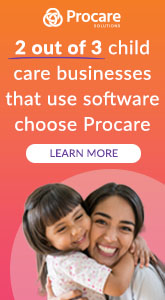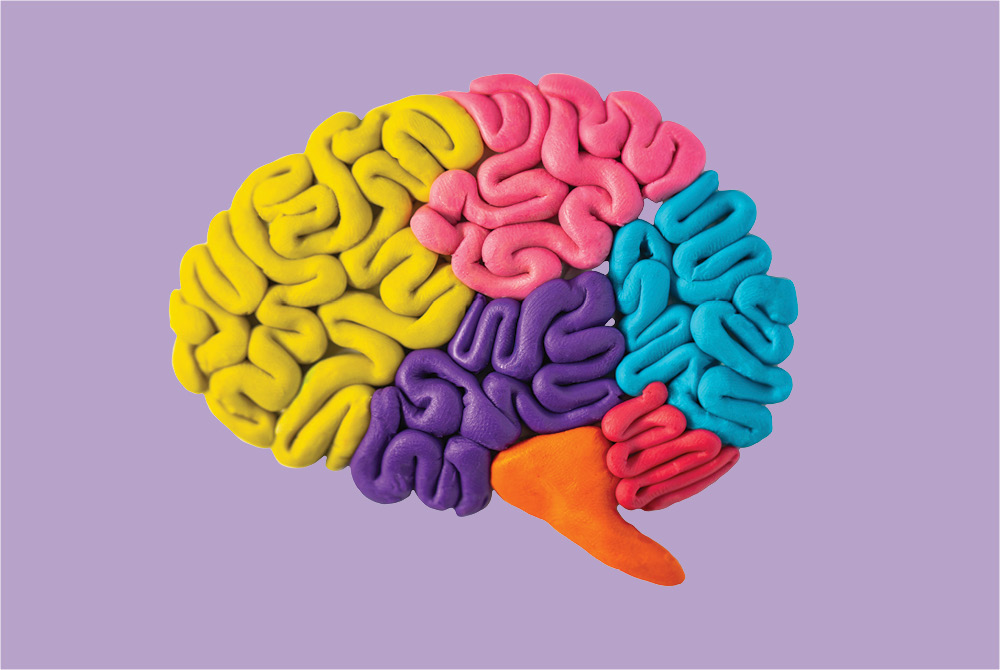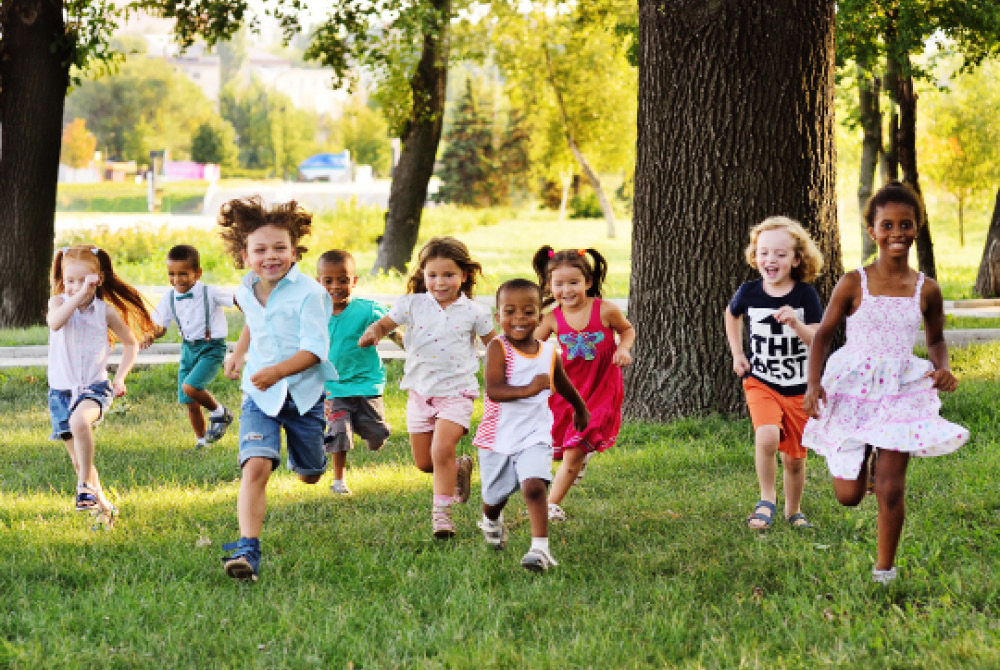Anyone who works with and cares for young children will agree: they are endlessly curious! There is no limit to a child’s engagement with the world via playful wonder, joyful noticing and enthusiastic inquiry. Indeed, children are born to learn—their minds and brains having evolved over tens of thousands of years to allow them to gain complex cognitive skills, such as native- and second-languages, musical instruments and divergent thinking. They do this seemingly effortlessly, and certainly more easily than adults. Curiosity provides children with opportunities for seeking, practicing and refining new abilities, making it the driving force behind the acquisition skills and knowledge. Understanding the cognitive science and neuroscience of curiosity is an important step toward maximizing children’s learning in the early childhood classroom.
Scientific Research Shows: Novelty Drives Curiosity
The seeds of curiosity lie in exploring. Right from birth, infants and young children choose to look at, listen to or play with things they have never experienced before. This novelty preference is a sign of robust development and health, and is an efficient way for immature cognitive systems to process information; it first helps babies survive by making sure that they pay attention to anything in our environment that can help or harm them (Lloyd, et al., 2019). It then develops into the insatiable urge to explore and experience new things. Novelty-seeking is a fundamental feature of behavior, shared by almost all organisms possessing nervous systems (Slater, 2004), but studies show that children who are significantly more interested in new things show superior cognitive skills, indicating that curiosity corresponds to learning and intelligence (Cahill-Solis & Witryol, 1994). The whole world is novel to a child, and in order to learn most efficiently, curious children need opportunities to explore, experiment and play, in order to get to know their surrounds. To maximize novelty in the early childhood classroom:
- Rotate toys and manipulatives so that young children have weekly, daily and hourly opportunities for newness.
- Model using materials in new ways (e.g., stacking cans, hiding things in boxes, placing items of interest low and high); use common objects (such as aluminum foil, found objects and loose parts) for both new artistic and new functional purposes.
- Within a secure routine, switch it up for special events, unset patterns of expectation.
- Let children make choices for how to set up their physical space.
- Make solving problems more transparent, complex and stimulating.
- Know when to throw out the schedule and let the structure be driven by authentic opportunities (e.g., when children get deeply engaged in something or when something exciting happens, such as unexpected snowfall).
Scientific Research Shows: Curiosity Releases Dopamine
When children are genuinely curious and seek to satisfy their questions and desires, their brains’ desire and reward system produces the pleasure producing neurotransmitter dopamine. In one important fMRI brain study, questions that were sincerely fascinating greatly increased activity in the brain regions involved in joy and reward. Further, when participants were in a curious state, their brains’ surge in dopamine caused them to more deeply take in and remember the entire landscape of experience and information. This is because dopamine makes the hippocampus (the part of the brain associated with long-term memory) function better. Indeed, higher curiosity when asking questions was correlated with better recall of surprising answers up to two weeks later (Gruber, Gelman & Ranganath, 2014; Kang et al, 2009). In other words, getting a child’s brain into a curiosity state made their learning deeper, more nuanced and broad, and more long-lasting. In a related study, when elementary school aged students read books on topics they were already wondering about, they learned significantly more information, picked out more details, and retained what they learned for longer periods of time (Engel, 2011). To maximize dopamine’s effects in the early childhood classroom:
- Invite and encourage children to pursue their curiosity; let children get carried away in things that they are sincerely interested in.
- Make space for authentic and emergent experiences, possibility and ownership.
- Observe and document young children’s genuine questions, ideas and interests, and integrate them into the curriculum.
- Stretch children’s curiosity to include other things nearby to their interests; scaffold their current knowledge and expand it into related territory.
- Transform curiosity episodes into genuine inquiry by providing a framework for children to test their own hypotheses and answer their own questions.
- Guide the inquiry of children without imposing your own agendas for their time.
Scientific Research Shows: Play and Imagination Are Curiosity in Action
Everywhere that there are children, there will be play and imagination, pretend and creativity. These are essential manifestations of children’s curiosity (Goncu, Jain & Tuernmer, 2006). Children learn most of the skills that they will need to be effective in the classroom and in life via play, which they automatically do and cannot be stopped from doing. Curiosity play uses existing knowledge and skills, encourages the struggle to master new competences, and is a process of manipulating, exploring, discovering and practicing (Bruce, 1991). Classic studies have shown that preschoolers who are allowed unstructured, free playtime with objects can use them more effectively to solve problems (e.g., Cheyne & Rubin, 1983). In a recent study, 3- and 4-year-old children who were allowed to follow their curiosity developed significantly more knowledge about a toy’s functions (Taffoni et al., 2014). Furthermore, active play (vigorous intensity measured by accelerometer) in preschoolers predicted better self-regulation and better achievement on higher scores on early reading and math indices (Becker, McLelland, Loprinizi & Trost, 2014).
ADVERTISEMENT
Imaginative play is particularly beneficial to developing curiosity. Role-playing is indeed a sophisticated cognitive skill, involving planning with other actors in real time, creating appropriate voices and actions, and imagining the thoughts and feelings of the character one is playing (Brill, 2004). Imaginative children show superior cognitive development and academic success. In an important study, children who use their imaginations more and engaged in more fantasy play in first and second grades scored higher on measures of divergent thinking—the number one desirable skill for 21st century success—in the 11th and 12th grades (Russ, 2003). In another recent study, preschoolers whose imaginative pretend play included impersonating others (playing the father or playing the teacher, for instance) were better at understanding others’ emotions, over children who did not impersonate. Kids who are great pretenders are also more skilled at inferring and predicting the thoughts and feelings of others (Schwebel, Rosen, & Singer, 1999). To maximize play and imagination in the early childhood classroom:
- Leave as much opportunity for free unstructured play time as possible (preferably outdoors).
- Make open-ended materials and toys readily available; let kids touch the materials and manipulatives and use them how they want to.
- Design lessons that are more like improv rather than scripted play.
- Create dramatic and role play areas and centers.
- Model role-playing: act out stories and pretend scenarios together.
Scientific Research Shows: Children Express Curiosity via Questions
Children are marvelously, ineffably inquisitive, and asking questions is one of the hallmarks of curiosity. Asking begins with not knowing and wanting to know. In one cognitive science study of children’s questions, preschool aged children were wired with recording devices throughout a typical day at home. The children asked an average of 76 information-seeking questions per hour, both in search of facts and in search of explanations (with one child asking her poor mother 145 questions in a single hour!) (Chouinard, Harris & Maratsos, 2007).
However, subsequent research revealed that children’s expressions of wonder, in particular their questions, declined dramatically once they entered formal schooling. In school, teachers tend to ask the questions as a part of guiding the curriculum and pedagogy toward their goals. By kindergarten, curiosity episodes—including children’s own questions—averaged only about two to five times during any two-hour stretch. By the fifth grade, self-generated questioning was strikingly absent, with zero to two episodes per visit being average. In other words, most children were spending seven or more hours of their day in school without asking even one question, and without taking part in even one behavior aimed at finding out something new (Engel, 2011). While children are natural question askers, whether or not they continue to ask questions depends in large part on how adults respond to them (Sternberg, 1994). To maximize children’s questioning in the early childhood classroom:
- Create an environment where questions are welcomed and schedules include time for questions.
- Answer questions with more questions (ask, “Why do you think that might be?” rather than providing easy answers.)
- Encourage kids to reframe and refine their own questions.
- Help children change their closed-ended questions (those with just one answer) into more open-ended questions (those that could be answered in many ways or from multiple perspectives).
- Guide questions into inquiry projects, both large and small.
Scientific Research Shows: Teachers and Caregivers Can Enhance or Quash Curiosity
Teachers and caregivers’ views on curiosity have a substantial impact on children’s manifestation of it. In one study, preschoolers were much more likely to explore new, unusual environments in the presence of warm and supportive adults than they were with critical or aloof adults (Moore & Bulbulian, 1976). In a related study, children were significantly more likely to curiously engage in a museum exhibit when teachers encouraged from the sidelines, used non-controlling language, and encouraged their autonomy (Eckes, Großmann & Wilde, 2018). The number one predictor of how elementary-aged students actively investigated a curiosity box (a big cabinet with 18 drawers containing never-before-seen items) was the teacher’s orientation toward curiosity. When their teacher smiled and encouraged it, children felt invited to use their bodies and minds to investigate. When the classroom was less open to curiosity, it was notably absent (Engel, 2011). In a notable experiment, children conducted science experiments with a teacher who modeled genuine inquiry or not. Then, the children were given free time to do whatever they wanted. The children who had worked with a curious, enthusiastic and experimental teacher were significantly more likely to keep experimenting with the materials (and continue their learning) during the free period (Engel, 2015).
Indeed, classroom structures and timeframes can and do block children’s genuine and spontaneous inquiry (Rop, 2003). As we increasingly schedule every minute of children’s time, we are depriving them of opportunities to develop and practice self-regulation and other important skills such as planning and problem solving. In a powerful recent research study, children who spent more unstructured time both inside and outside of classrooms showed superior executive functioning, the number one predictor of student success in school (Barker et al., 2014). To maximize and not quash curiosity in the early childhood classroom:
- Always give equal consideration to your own goals and the goals of the children.
- Give kids plenty of time to wonder and wander.
- Unstructure the schedule; be flexible for unplanned exciting play and learning moments to occur.
- Let children’s own curiosity guide what they get to do; offer choices in activities, choices in quiet time; choices in books to read/have read to them.
- Explore emergent curriculum, building authentic learning experiences around their expressed questions, comments, ideas and interests.
The cognitive science research is abundantly clear: curiosity is a powerful engine for deep and lasting learning. It springs forth from novelty preference, and is nourished by the spontaneous and joyful inquiry, imagination and play that all children seek. Curiosity changes the child’s brain, priming them to engage, notice and remember in powerful ways. But curiosity is highly dependent on the experiences available to the developing child. As educators and caregivers, it is up to us to create early learning environments which will nurture and cultivate curiosity, and which will not squash it. A curious child must be empowered to wonder and to explore. In the immortal words of Albert Einstein, “Curiosity is a delicate little plant which, aside from stimulation, stands mainly in need of freedom.”
References
Barker, J.E., Semenov, A.D., Michaelson, L. Provan, L.S., Snyder, H.R., & Munakata (2014). Less-structured time in children’s daily lives predicts self-directed executive functioning. Frontiers in Psychology | Developmental Psychology, 5(593), 1-16.
Becker, D.R., McClelland, M.M., Loprinzi, P., & Trost, S.G. (2014). Physical activity, self-regulation, and early academic achievement in preschool children. Early Education and Development, 25(1), 56-70.
Brill, F. (2004). Thinking outside the box: Imagination and empathy beyond story writing. Literacy, 38, 83-89.
Bruce, T. (1991). Time to play in early childhood education. London, UK: Hodder & Stoughton.
Cahill-Solis, T.L., & Witryol, S.L. (1994). Children’s exploratory play preferences for four levels of novelty in toy constructions. Genetic, Social, and General Psychology Monographs, 120(4), 393–408.
Cheyne, J.A., & Rubin, K.H. (1983). Playful precursors of problem solving in preschoolers. Developmental Psychology, 19(4), 577–584.
Chouinard, M.M., Harris, P.L., & Maratsos, M.P. (2007). Children’s questions: A mechanism for cognitive development. Monographs of the Society for Research in Child Development, 72(1), 1–129.
Eckes, A., Großmann, N. & Wilde, M. (2018). Studies on the effects of structure in the context of autonomy-supportive or controlling teacher behavior on students’ intrinsic motivation. Learning and Individual Differences, 62, 69-78.
Einstein, A. (1949/1999). Autobiographical notes. Open Court Press.
Engel, S. (2011). Children’s need to know: Curiosity in schools. Harvard Educational Review, 81, 625-626.
Engel, S.L. (2015). The hungry mind: The origins of curiosity in childhood. Harvard University Press.
Goncu, A., Jain, J., & Tuernmer, U. (2007). Children’s play as cultural interpretation. In A. Goncu & S. Gaskins (Eds.), Play and Development: Evolutionary, Sociocultural, and Functional Perspectives (pp. 155-178). Mahwah, NJ: LEA.
Gruber, M., Gelman, B. & Ranganath, C. (2014). States of curiosity modulate hippocampus-dependent learning via the dopaminergic circuit. Neuron, 84(2), 486-496.
Kang, M.J., Hsu, M., Krajbich, I., Loewenstein, G., McClure, S.M., Wang, J.T. & Camerer, C.F.
(2009). The wick in the candle of learning: Epistemic curiosity activates reward circuitry and enhances memory. Psychological Science, 20(8), 963-973.
Lloyd, F.S., Blasi, A., McCann, S., Rozhko, M., Katus, L., Mason, L., Austin, T., Moore, S.E., & Elwell, C.E. (2019). Habituation and novelty detection fNIRS brain responses in 5- and 8-month-old infants: The Gambia and U.K.
Moore, S.G., & Bulbulian, K.N. (1976). The effects of contrasting styles of adult-child interaction on children’s curiosity. Developmental Psychology, 12(2), 171–172.
Rop, C.J. (2003). Spontaneous inquiry questions in high school chemistry classrooms: Perceptions of a group of motivated learners. International Journal of Science Education, 25(1), 13-33.
Russ, S. (2003). Play and creativity: Developmental issues. Scandinavian Journal of Educational Research, 47, 291-303.
Schwebel, D.C., Rosen, C.S., & Singer, J.L. (1999). Preschoolers’ pretend play and theory of mind: The role of jointly conducted pretense. British Journal of Developmental Psychology, 17, 333-348.
Slater, A. (2004). Novelty, familiarity, and infant reasoning. Infant and Child Development, 13, 353–355.
Sternberg, R. J. (1994). Answering questions and questioning answers. Phi Delta Kappan, 76(2), 136–138.
Taffoni, F., Tamilia, E., Focaroli, V., Formica, D., Ricci, L., Di Pino, G., Keller, F. (2014). Development of goal-directed action selection guided by intrinsic motivations: an experiment with children. Experimental Brain Research, 232(7), 2167+.
Wendy L. Ostroff, Ph.D., is an applied developmental and cognitive psychologist and professor in the Hutchins School of Liberal Studies at Sonoma State University, a pioneering interdisciplinary and seminar-based program that prepares prospective teacher/learners to be critical readers, writers, and thinkers who bridge cognitive science with innovative pedagogies. The author of the books "Understanding How Young Children Learn" (2012), "Cultivating Curiosity in K-12 Classrooms" (2016), and "Empowering Young Children" (2022), Ostroff is an award-winning educator with more than 20 years of experience in state-of-the-art teacher training. She leads workshops and professional development events worldwide on curiosity, cognition, and the brain.
Related
ADVERTISEMENT












